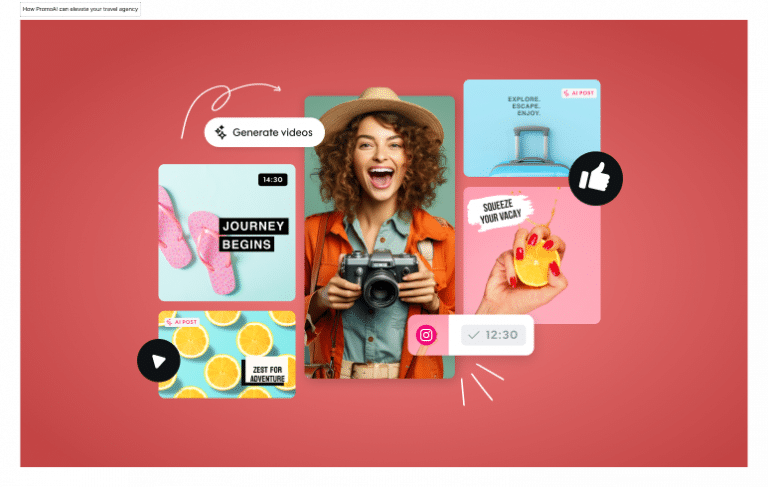
Marketing E-Commerce Business on Social Media
The e-commerce industry is booming. By 2026, 24% of retail purchases are expected to take place online, and e-commerce sales are expected to grow 10.4% in 2023. This makes e-commerce business an attractive prospect with a lot of potential. The trick is figuring out how to stand out in a crowded, competitive landscape, winning over customers’ attention and buyers’ dollars.
One place to start? Social media marketing. The significance of a robust social media presence can’t be overstated, as it serves as a direct gateway to engage with your audience, showcase your products, and drive business growth.
In this blog post, we’ll explore everything you need to know as a small e-commerce business about how to promote your business on social media. We’ll delve into:
- How and why to set social media marketing goals
- How to define your brand voice
- Choosing the right social media platforms
- Recommended posting frequencies
- Tips for keeping up with your posting schedule
- E-commerce-specific social media marketing tips
It’s time to unlock the full potential of social media for your e-commerce venture – let’s dive in.
Setting Social Media Marketing Goals
Even as a small e-commerce business, you’ll want to take some time before you dive into social media marketing in order to create a social media strategy that will guide your decision-making. And the best way to craft a successful strategy is to start by setting clear and measurable goals.
Not sure where to start? Look at your overarching business goals. Ideally, each of your social media goals should be aligned with larger business objectives.
Some examples of SMART (specific, measurable, achievable, relevant, and time-bound) social media goals include:
- Increase brand awareness: Increase brand awareness by reaching 50,000 new followers on Instagram within the next quarter, aiming for a 20% increase in monthly follower growth through influencer collaborations, targeted ads, and a user-generated content campaign.
- Drive website traffic: Increase website traffic by 30% within the next six months, utilizing social media advertising, regular content sharing, and compelling calls to action to achieve incremental monthly goals and enhance overall online visibility.
- Boost sales: Achieve a 20% increase in online sales over the next quarter by implementing targeted advertising campaigns, offering exclusive promotions, and optimizing the online shopping experience, with monthly targets set to track progress and drive consistent growth.
Defining the Brand Voice and Personality
Another important step to take before posting on social media is to develop a strong sense of your brand voice. Some keys to keep in mind include:
Recognizability
Why it’s important: A recognizable brand voice ensures that your audience can easily identify and differentiate your business from competitors. Consistency in messaging and tone across various channels builds a strong brand identity, making it memorable for consumers.
Tips to achieve recognizability:
- Define key brand elements, such as a unique tagline, color palette, and logo, to maintain visual consistency.
- Establish a consistent tone of voice that reflects your brand’s personality across all communication channels.
- Use branded hashtags consistently in social media posts to create a cohesive online presence.
Authenticity
Why it’s important: Authenticity builds trust and fosters genuine connections with your audience. Consumers are more likely to engage with and remain loyal to a brand that communicates transparently and authentically.
Tips to achieve authenticity:
- Be transparent about your brand values, mission, and any behind-the-scenes aspects of your business.
- Share real customer stories and testimonials to showcase authentic experiences with your products or services.
- Respond genuinely to both positive and negative feedback, demonstrating a commitment to improvement and customer satisfaction.
Consistency
Why it’s important: Consistency in your brand voice across different touchpoints helps reinforce your brand identity. It creates a cohesive and reliable image, which is crucial for establishing brand recall and trust with your audience.
Tips to achieve consistency:
- Develop brand guidelines outlining preferred language, tone, and messaging to ensure a unified voice.
- Regularly review and update your guidelines to adapt to changing trends or shifts in your brand’s identity.
- Provide training for team members responsible for social media management to ensure a consistent voice across all interactions.
Humanity or Relatability
Why it’s important: Adding a human touch to your brand voice makes your business more relatable, creating a connection with your audience on a personal level. This relatability can lead to increased loyalty and engagement.
Tips to achieve humanity or relatability:
- Incorporate storytelling into your content, sharing anecdotes or narratives that resonate with your audience.
- Use conversational language and engage with your audience in a friendly, approachable manner.
- Showcase the people behind your brand through employee spotlights or behind-the-scenes content to humanize your business.
Choosing the Right Platforms
There is no shortage of social media platforms out there but, as a small business, your resources are limited. So how do you know which platforms to invest in? Let’s do a quick overview of the most popular options out there.
- Facebook: With its extensive user base, Facebook provides a versatile space for engaging content and targeted advertising
- Instagram: Known for its visually-driven content, Instagram is ideal for businesses with visually appealing products
- Twitter: Twitter’s fast-paced environment suits businesses aiming for real-time engagement
- TikTok: The newest, fastest-growing social media platform, TikTok is well-suited to businesses aiming to reach a younger demographic
One of the main considerations you’ll want to keep in mind when choosing your social media platforms — as well as every other social media marketing decision you’ll need to make – is your target audience. It’s important to know your target customer’s age, gender, location, and interests in order to effectively tailor your content to your audience. For instance, if your e-commerce business caters to a younger demographic, platforms like Instagram and TikTok might be particularly impactful.
Ultimately, the selection of the most effective platforms is a strategic decision based on your business goals and the nature of your products. Strive to match your brand’s identity with the platform’s atmosphere. Whether it’s the visual appeal of Pinterest for lifestyle products or the community-driven nature of Facebook groups for niche markets, understanding the platform’s strengths is crucial.
Content Posting Frequency and Consistency
In order to create a predictable experience for your audience, win the algorithms’ favor, and get your content in front of as large of an audience as possible, consistency is absolutely key. While quality is no less important than quantity, you’ll be more likely to see success if you stick with the following posting frequencies:
| Social Media Platform | Ideal Posting Frequency | Source |
| 2 feed posts per week and 2 stories per day | Adam Mosseri (Head of Instagram) | |
| Once a day to 5 times a month | Hubspot | |
| TikTok | 1 to 4 times per day | TikTok |
| YouTube | At least one video per week | YouTube Strategist Maria Concepcion Zabala |
Tips for Keeping Up With Your Content Schedule
Posting once or more a day is a challenge for businesses of any size, but small businesses may find it especially difficult. But with the right tools and solutions, even the smallest team can keep up with the big brands.
First, it’s key to use a content calendar, or a planning tool used to organize and schedule content creation and publication over a specified period. Benefits of using a content calendar include:
- Consistency: Ensures a consistent and regular flow of content, which is crucial for maintaining audience engagement.
- Organization: Streamlines the content creation process, making it easier to manage workflows and deadlines.
- Strategic planning: Facilitates strategic planning by aligning content with business objectives and marketing goals.
- Collaboration: Enhances collaboration among team members by providing a centralized platform for planning and communication.
And if you need help coming up with content ideas, as well as actually creating engaging, compelling, high-quality content, look no further than PromoAI. Promo’s newest game-changing solution, PromoAI uses the power of AI to analyze your website and create a full monthly content calendar for you populated with 30 videos and captions customized with your branding, messaging, and target audience.
You have the power to edit any elements of your post that you want before approval, and PromoAI will publish directly to your social media accounts for you. It’s like having an entire social media marketing team on your staff without the cost, letting you market your e-commerce business like the big brands at a fraction of the time and effort.
Best Practices for E-Commerce Business on Social Media
As an e-commerce business, there are certain specific considerations you may want to keep in mind when building your social media strategy. These include:
- Plan content around product releases and promotions: Align your content calendar with your e-commerce calendar, incorporating product launches, promotions, and seasonal sales. Highlighting specific products at strategic times maximizes engagement.
- Utilize shopping features: Leverage e-commerce features on social media platforms, such as Instagram Shopping and Facebook Shops, to create a seamless shopping experience directly from your social profiles.
- Collaborate with product-relevant influencers: Identify influencers within your product niche to collaborate with. Their authentic promotion of your products can introduce your brand to a broader audience and boost product credibility.
- Promote limited-time offers and exclusives: Create a sense of urgency and exclusivity by promoting limited-time offers, flash sales, or exclusive product releases on social media. Encourage immediate action from your audience.
Time to Get Social
As we’ve seen above, mastering the art of social media marketing is a game-changer for e-commerce businesses. By setting SMART goals, defining a clear brand voice, and committing to a consistent posting schedule, even the smallest business can find success on social media.
With PromoAI on your side, you have what it takes to market your e-commerce venture like industry giants—without the hefty costs. Try it out today to unlock the full potential of social media for your e-commerce business. Your e-commerce success story awaits!



